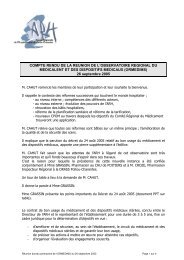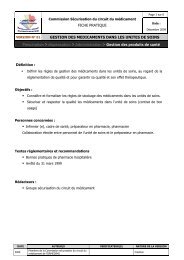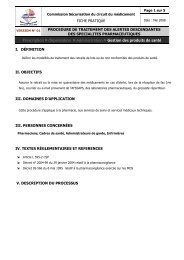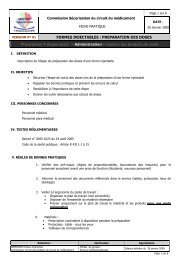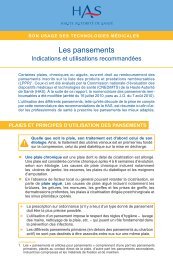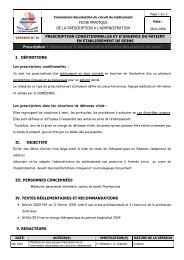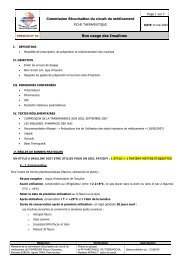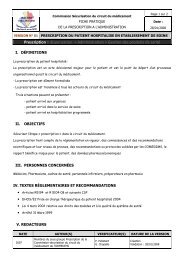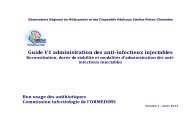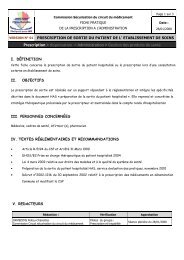Aminosides toujours et encore - OMEDIT Poitou-Charentes
Aminosides toujours et encore - OMEDIT Poitou-Charentes
Aminosides toujours et encore - OMEDIT Poitou-Charentes
You also want an ePaper? Increase the reach of your titles
YUMPU automatically turns print PDFs into web optimized ePapers that Google loves.
S8 Réanimation<br />
Tableau 5 Optimisation de la prescription des aminosides<br />
– Le plus souvent utilisation en association<br />
– Indication en début de traitement : inoculum potentiellement<br />
élevé <strong>et</strong> incertitudes sur l’efficacité du traitement (germe(s)<br />
<strong>et</strong> CMI inconnues)<br />
– Choix de la molécule en fonction du germe en cause ou<br />
suspectée <strong>et</strong> des propriétés microbiologiques propres à<br />
chaque aminoside<br />
– Utilisation d’une DUJ (perm<strong>et</strong> d’atteindre les objectifs Pk/<br />
Pd : Cmax/CMI > 8–10)<br />
Posologies élevées dans toutes les situations sévères<br />
Perfusion IV de 30 min<br />
– Durée de traitement ≤ 5 jours (rapport bénéfice/sécurité<br />
d’emploi optimal) ; le plus souvent arrêt à 48–72 heures<br />
(r<strong>et</strong>our de l’antibiogramme)<br />
– Pas de dosage plasmatique si durée ≤ 3 jours,<br />
sauf si insuffisance rénale <strong>et</strong> si patients sévères<br />
– Insuffisance rénale : les objectifs Pk/Pd restent les mêmes,<br />
donc posologies identique à celle d’un suj<strong>et</strong> sain <strong>et</strong><br />
espacement des doses en fonction des données de la<br />
résiduelle<br />
– Suj<strong>et</strong>s > 75 ans : pas de schéma posologique particulier,<br />
adapter l’espacement des doses à la fonction rénale<br />
utilisé seul, surtout dans les infections à bacilles à Gram<br />
négatif. Mais aucune des études, ni des méta-analyses réalisées<br />
dans ce contexte, n’est exempte de problème méthodologique<br />
(mélange de patients sévères <strong>et</strong> d’infection moins<br />
sévère, utilisation de bêtalactamines variées, même au sein<br />
de la même étude…). Il semble nécessaire pour avoir des<br />
réponses de pouvoir disposer d’études cliniques évaluant la<br />
même bêtalactamine en monothérapie ou en association avec<br />
un aminoside unique sur les infections à P. aeruginosa <strong>et</strong> les<br />
endocardites à cocci à Gram positif. En revanche, l’évolution<br />
actuelle des résistances justifie dans de nombreuses circonstances<br />
l’ajout d’un aminoside, dans le but d’élargir le spectre<br />
d’activité d’une antibiothérapie probabiliste, surtout dans les<br />
tableaux infectieux sévères. Dans ces conditions où le partenaire<br />
associé risque d’être inactif, il est primordial d’optimiser<br />
la prescription des aminosides. Pour les infections<br />
urinaires, mais également pour d’autres infections à bacilles<br />
à Gram négatif, la question de la monothérapie par un aminoside<br />
risque de se poser en fonction de l’évolution des<br />
résistances. Et dans ce type de situations, la balance bénéfice/risque<br />
devra intégrer d’autres paramètres (mortalité<br />
globale, pression écologique…) en plus de ceux actuellement<br />
utilisés (toxicité <strong>et</strong> efficacité).<br />
Conflit d’intérêt : l’auteur déclare ne pas avoir de conflit<br />
d’intérêt.<br />
Références<br />
1. Chuck SK, Raber SR, Rodvold KA, <strong>et</strong> al (2000) National survey<br />
of extended-interval aminoglycosides dosing. Clin Infect Dis<br />
30:433–9<br />
2. Leong CL, Bulsing K, Richards M, <strong>et</strong> al (2006) Providing guidelines<br />
and education is not enough: an audit of gentamicin use at<br />
the Royal Melbourne hospital. Intern Med J 36:37–42<br />
3. Zahar JR, Rioux C, Girou E, <strong>et</strong> al (2006) Inappropriate prescribing<br />
of aminoglycosides: risk factors and impact of an antibiotic<br />
control team. J Antimicrob Chemother 58:651–9<br />
4. Begg EJ, Vella-Brincat JWA, Robertshawe B, <strong>et</strong> al (2009) Eight<br />
years experience of an extented-interval dosing protocol for gentamicin<br />
in neonates. J Antimicrob Chemother 63:1043–9<br />
5. Rea RS, Capitano B (2007) Optimizing use of aminoglycosides<br />
in the critically ill. Semin Respir Crit Care Med 28:596–603<br />
6. Drgona L, Paul M, Bucaneve G <strong>et</strong> al (2007) The need for aminoglycosides<br />
in combination with ß-lactams for high-risk, febrile neutropaenic<br />
patients with leukaemia. Eur J Cancer 43(Suppl 5):13–22<br />
7. Paul M, Benury-Silbiger I, Soares-Weiser K, <strong>et</strong> al (2004) B<strong>et</strong>alactam<br />
monotherapy versus ß-lactam-aminoglycoside combination<br />
therapy for sepsis in immunocomp<strong>et</strong>ent patients: systématic<br />
review and m<strong>et</strong>a-analysis of randomised trials. BMJ 328:668–72<br />
8. Paul M, Silbiger L, Grozinsky S, <strong>et</strong> al (2006) B<strong>et</strong>alactam antibiotic<br />
monotherapy versus b<strong>et</strong>a lactam-aminoglycoside antibiotic<br />
combination therapy for sepsis. Cochrane Database Syst Rev<br />
25(1):CD003344<br />
9. Martínez JA, Cobos-Trigueros N, Soriano A, <strong>et</strong> al (2010) Influence<br />
of empiric therapy with a b<strong>et</strong>a-lactam alone or combined with an<br />
aminoglycoside on prognosis of bacteremia due to Gram-negative<br />
microorganisms. Antimicrob Agents Chemother 54(9):3590–6<br />
10. Habib G, Hoen B, Tornos P, <strong>et</strong> al (2009) Guidelines on the prevention,<br />
and treatment of infective endocarditis (new version<br />
2009): the task force on the prevention, diagnosis and treatment<br />
of infective endocarditis of the European Soci<strong>et</strong>y of Cardiology<br />
(ESC). Eur Heart J 30:2369–413<br />
11. Maller R, Ahrne H, Holmen C, <strong>et</strong> al (1993) Once versus twicedaily<br />
amikacin regimen: efficacy and saf<strong>et</strong>y in systemic Gramnegative<br />
infections. Scandinavian Amikacin Once-Daily Study<br />
Group. J Antimicrob Chemother 31:939–48<br />
12. Prins JM, Buller HR, Kuijper EJ, <strong>et</strong> al (1994) Once-daily gentamicin<br />
versus once-daily n<strong>et</strong>ilmicin. J Antimicrob Chemother<br />
33:823–35<br />
13. Bertino JS Jr, Booker LA, Franck PA, <strong>et</strong> al (1993) Incidence of<br />
an significant risk factors for aminoglycoside-associated nephrotoxicity<br />
in patients dosed by using individualized pharmacokin<strong>et</strong>ic<br />
monitoring. J Infect Dis 167:173–9<br />
14. Drusano GL, Ambrose PG, Bhavnani SM, <strong>et</strong> al (2007) Back to<br />
the future: using aminoglycosides again and how to dose them<br />
optimally. Clin Infect Dis 45:753–60<br />
15. De Broe ME, Paulus GT, Verpooten GA, <strong>et</strong> al (1984) Early<br />
effects of gentmicin, tobramycin and amikacin on the human<br />
kidney. Kidney Int 25:643–52<br />
16. Recommandations de bonne pratique (2008) Diagnostic <strong>et</strong> antibiothérapies<br />
des infections urinaires bactériennes communautaires<br />
chez l’adulte – Affsaps. http://www.afssaps.fr<br />
17. Leibovici L, Vidal L, Paul M (2009) Aminoglycosides drugs in<br />
clinical practice: an evidence-based approach. J Antimicrob Chemother<br />
63:246–51<br />
18. Bliziotis IA, Samonis G, Vardakas KZ, <strong>et</strong> al (2005) Effect of aminoglycoside<br />
and b<strong>et</strong>alactam combination therapy versus b<strong>et</strong>alactam<br />
monotherapy on the emergence of antimicrobial resistance: a<br />
m<strong>et</strong>a-analysis of randomized, controlled trials. Clin Infect Dis<br />
41:149–58





